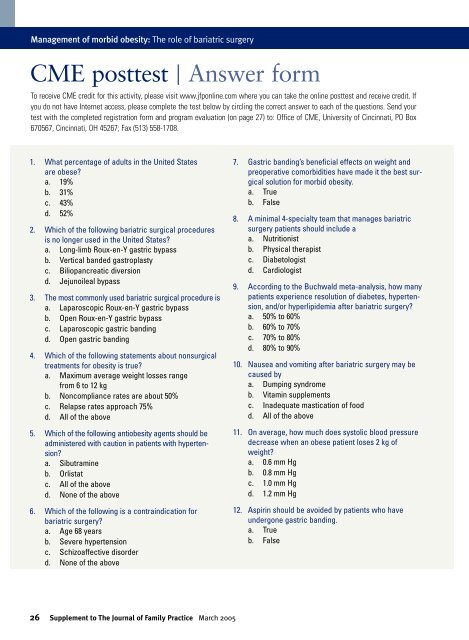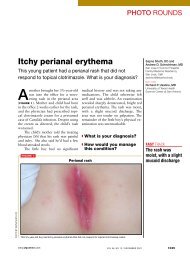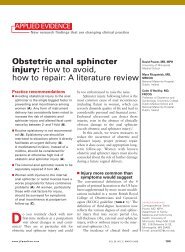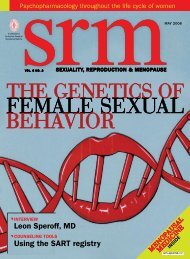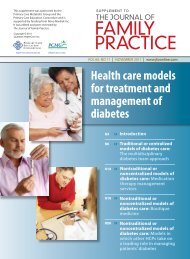Management of morbid obesity - The Journal of Family Practice
Management of morbid obesity - The Journal of Family Practice
Management of morbid obesity - The Journal of Family Practice
You also want an ePaper? Increase the reach of your titles
YUMPU automatically turns print PDFs into web optimized ePapers that Google loves.
<strong>Management</strong> <strong>of</strong> <strong>morbid</strong> <strong>obesity</strong>: <strong>The</strong> role <strong>of</strong> bariatric surgery<br />
CME posttest | Answer form<br />
To receive CME credit for this activity, please visit www.jfponline.com where you can take the online posttest and receive credit. If<br />
you do not have Internet access, please complete the test below by circling the correct answer to each <strong>of</strong> the questions. Send your<br />
test with the completed registration form and program evaluation (on page 27) to: Office <strong>of</strong> CME, University <strong>of</strong> Cincinnati, PO Box<br />
670567, Cincinnati, OH 45267; Fax (513) 558-1708.<br />
1. What percentage <strong>of</strong> adults in the United States<br />
are obese?<br />
a. 19%<br />
b. 31%<br />
c. 43%<br />
d. 52%<br />
2. Which <strong>of</strong> the following bariatric surgical procedures<br />
is no longer used in the United States?<br />
a. Long-limb Roux-en-Y gastric bypass<br />
b. Vertical banded gastroplasty<br />
c. Biliopancreatic diversion<br />
d. Jejunoileal bypass<br />
3. <strong>The</strong> most commonly used bariatric surgical procedure is<br />
a. Laparoscopic Roux-en-Y gastric bypass<br />
b. Open Roux-en-Y gastric bypass<br />
c. Laparoscopic gastric banding<br />
d. Open gastric banding<br />
4. Which <strong>of</strong> the following statements about nonsurgical<br />
treatments for <strong>obesity</strong> is true?<br />
a. Maximum average weight losses range<br />
from 6 to 12 kg<br />
b. Noncompliance rates are about 50%<br />
c. Relapse rates approach 75%<br />
d. All <strong>of</strong> the above<br />
5. Which <strong>of</strong> the following anti<strong>obesity</strong> agents should be<br />
administered with caution in patients with hypertension?<br />
a. Sibutramine<br />
b. Orlistat<br />
c. All <strong>of</strong> the above<br />
d. None <strong>of</strong> the above<br />
6. Which <strong>of</strong> the following is a contraindication for<br />
bariatric surgery?<br />
a. Age 68 years<br />
b. Severe hypertension<br />
c. Schizoaffective disorder<br />
d. None <strong>of</strong> the above<br />
26 Supplement to <strong>The</strong> <strong>Journal</strong> <strong>of</strong> <strong>Family</strong> <strong>Practice</strong> March 2005<br />
7. Gastric banding’s beneficial effects on weight and<br />
preoperative co<strong>morbid</strong>ities have made it the best surgical<br />
solution for <strong>morbid</strong> <strong>obesity</strong>.<br />
a. True<br />
b. False<br />
8. A minimal 4-specialty team that manages bariatric<br />
surgery patients should include a<br />
a. Nutritionist<br />
b. Physical therapist<br />
c. Diabetologist<br />
d. Cardiologist<br />
9. According to the Buchwald meta-analysis, how many<br />
patients experience resolution <strong>of</strong> diabetes, hypertension,<br />
and/or hyperlipidemia after bariatric surgery?<br />
a. 50% to 60%<br />
b. 60% to 70%<br />
c. 70% to 80%<br />
d. 80% to 90%<br />
10. Nausea and vomiting after bariatric surgery may be<br />
caused by<br />
a. Dumping syndrome<br />
b. Vitamin supplements<br />
c. Inadequate mastication <strong>of</strong> food<br />
d. All <strong>of</strong> the above<br />
11. On average, how much does systolic blood pressure<br />
decrease when an obese patient loses 2 kg <strong>of</strong><br />
weight?<br />
a. 0.6 mm Hg<br />
b. 0.8 mm Hg<br />
c. 1.0 mm Hg<br />
d. 1.2 mm Hg<br />
12. Aspirin should be avoided by patients who have<br />
undergone gastric banding.<br />
a. True<br />
b. False


